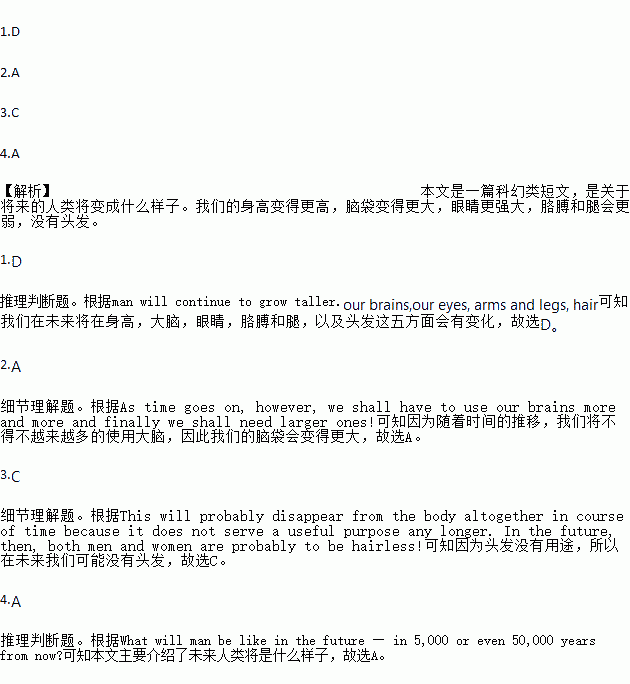题目内容
What will man be like in the future — in 5,000 or even 50,000 years from now? We can only make a guess, of course, but we can be sure that he will be different from what he is today. For man is slowly changing all the time.
Let us take an example. Man, even five hundred years ago, was shorter than he is today. Now, on the average, men are about three inches taller. Five hundred years is a relatively (相对地) short period of time, so we may suppose that man will continue to grow taller.
Again, in the modern world we use our brains a great deal. Even so, we still make use of only about 20% of the brain's capacity (容量.) As time goes on, however, we shall have to use our brains more and more and finally we shall need larger ones! This is likely to bring about a physical change too. The head, especially the forehead, will grow larger.
Nowadays our eyes are being used too much. In fact, we use them so much that very often they become weaker and we have to wear glasses. But over a very long period of time it is likely that man's eyes will grow stronger.
On the other hand, we tend (有…的趋势) to make less use of our arms and legs. These, as a result, are likely to grow weaker. At the same time, however, our fingers will grow more sensitive (敏感的) because they are used a great deal in modern life.
What about hair? This will probably disappear from the body altogether in course of time because it does not serve a useful purpose any longer. In the future, then, both men and women are probably to be hairless!
Perhaps, all this gives the impression that future man will not be a very attractive (有吸引力的) person to look at! This may well be true. All the same, besides these changes, future man will still have a lot in common with us. He will still be a human being, with thoughts and feelings similar to our own.
1.Future man is probably to be different from us in ________ ways.
A. two B. three C. four D. five
2.Future man’s head will grow larger because ________.
A. he will use his brain more and more as time goes on
B. he makes use only 80% of the brain's capacity
C. the other 80% of his brain will grow faster
D. his brain has grown larger over the past centuries
3.What will be probably TRUE about the man in the future?
A. He will have smaller eyes and will wear better glasses.
B. His fingers will grow weaker because he won't use them.
C. He will be hairless because hair is no longer useful.
D. He will think and feel in a different way.
4.What does the writer write the article for?
A. To give us some knowledge of future man.
B. To show that man's life will be different in the future.
C. To let us know future man will become shorter.
D. To tell us future man will not use legs.
随着网络的发展、人们消费观念的转变, 购物方式也在悄然的发生变化。“网购”已成为一种时尚,越来越多的学生也加入到网购群体中。请你根据以下表格的提示,写一篇网上购物的文章。
优点 (advantage) | 1.不需要出门;节约时间;避免拥挤、劳累 |
2.价格通常比较便宜 | |
3.可供选择的范围广,品种多 | |
缺点 (disadvantage) | 1.只看到图片, 看不到商品本身 |
2.容易购买大量不太需要的东西, 造成浪费 | |
你的观点 | …… |
提示词汇:网购shopping online; 商品 goods; 导致 cause
注意:1.所表述的内容必须包含表格中的所有方面,可适当发挥;
2.文中不能出现自己的姓名和所在学校的名称;
3.词数:100词左右,文章开头已给出,但不计入总数。
With the development of the Internet, many people are used to shopping online.

